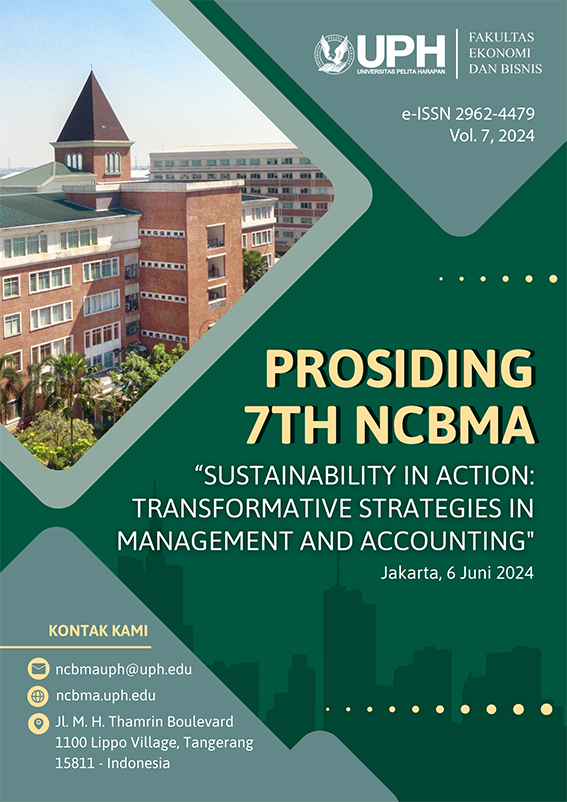Critical Analysis in Developing System Application And Product (SAP) and Internal Control
Keywords:
Accounting Information System, Internal control, Implementing SAP, Inventory theft, Critical AnalysisAbstract
This research is a critical analysis of the Accounting Information System (AIS) and its impact on internal control weaknesses. Although computer-based AIS offers significant advantages in speed, accuracy, and data processing efficiency, implementation can be complex and incur high costs for procurement of hardware, software, and ongoing maintenance. This research uses a case study from PT. BGA, where the subsidiary experienced inventory theft. During the centralized inventory process, significant discrepancies were discovered in the subsidiary's warehouse, resulting in huge losses for the parent company. Critical analysis reveals the weaknesses that exist in PT. BGA. The company uses a fragmented system, with SAP applications not yet fully implemented across all departments. Accounting data is still managed through additional applications such as MS Excel and transferred via email, creating potential gaps in data retrieval and consolidation in the SAP system. This fragmented approach increases the risk of incomplete or inaccurate data reaching headquarters for processing, ultimately contributing to undetected theft. This case study emphasizes the importance of comprehensive and integrated AIS. Implementing SAP across an organization will likely facilitate real-time data visibility and improve internal controls, thereby preventing inventory theft.
References
Adela, V., Agyei, S. K., Frimpong, S., Awisome, D. B., Bossman, A., Abosompim, R. O., . . . Ahmed, A. M. (2023). Bookkeeping practices and SME performance: The intervening role of owners’ accounting skills . Heliyon, 1-14.
Al-Okaily, M., & Al-Okaily , A. (2022). An empirical assessment of enterprise information systems success in a developing country: the Jordanian experience. The TQM Journal, 1958-1975.
Beasely, J. E. (2023). Internal Control: Integrated Framework (2023). New York: American Institute of Certified Public Accountants (AICPA).
Cahyaningrum, N., Gunawan, J., & Anis, I. (2022). Financial Distress dan Internal Control pada Earnings Management dengan Managerial Ownership Sebagai Moderasi. E-Jurnal Akuntansi OJS UNUD, 1506-1517.
Chen, A., Li, L., & Shahid, W. (2024). Digital transformation as the driving force for sustainable business performance: A moderated mediation model of market-driven business model innovation and digital leadership capabilities. Heliyon, 1-17.
Doyle, F., & Cosgrove, J. (2019). Steps towards digitization of manufacturing in an SME environment. Procedia Manufacturing, 540-547.
Gessa, A., Jim´enez, A., & Sancha, P. (2023). Exploring ERP systems adoption in challenging times. Insights of SMEs stories. Technological Forecasting and Social Change, 1-11.
Harasheh, M., & Provasi, R. (2022). A need for assurance: Do internal control systems integrate environmental, social, and governance factors?. Corporate Social Responsibility and Environmental Management, 384-401.
Indrayani, H. (2018). Penerapan Teknologi Informasi Dalam Peningkatan Efektivitas. JURNAL EL-RIYASAH, 48-56.
Jahel, C., Bourgeois, R., Bourgoin, J., Dare, W., Gasquet, M. D., Delay, E., . . . Prudhomme, R. (2023). The future of social-ecological systems at the crossroads of quantitative and qualitative methods . Technological Forecasting and Social Change, 1-16.
Kadir, A. (2022). Sistem Informasi Akuntansi: Esensi & Aplikasi. Yogyakarta: Andi Offset.
Kurnia. (2022). Analisis Risiko Kesalahan dalam Pencatatan Transaksi Keuangan pada Sistem Aplikasi dan Produk (SAP) di Perusahaan Manufaktur. Journal of Universitas Airlangga, 22.
Li, J., Xia, T., & Wu, D. (2021). Internal Control Quality, Related Party Transactions and Accounting Information Comparability. Procedia Computer Science, 1252-1259.
Lutfi, A. (2022). Factors Influencing the Continuance Intention to Use Accounting Information System in Jordanian SMEs from the Perspectives of UTAUT: Top Management Support and Self-Efficacy as Predictor Factors. Economies, 1-17.
Mulyana. (2022). Metode Penelitian Kualitatif: Paradigma Baru, Teori dan Aplikasi. Jakarta: PT. Rajagrafindo Persada.
Nguyen, H. T., T, R., Kweh, Q. L., Tran, P. T., & Minh, H. T. (2024). Determinants of accounting information system effectiveness and moderating role of external consultants: Empirical research in the Ben Tre Province of Vietnam . Heliyon, 1-13.
Nguyen, N. P., & Hoai, T. T. (2023). Internal controls driven by mindfulness toward enhanced ethical behaviors: Empirical evidence from Vietnam . Heliyon, 1-13.
Patuan, I., & Hermawan, A. A. (2023). THE EFFECT OF INTERNAL CONTROL ON THE RECEIVABLES MANAGEMENT. International Journal Of Contemporary Accounting (IJCA), 61-80.
Purnamasari, R., Hasanudin, A. I., Zulfikar, R., & Yazid, H. (2024). Do internal control and information systems drive sustainable rural development in Indonesia? . Journal of Open Innovation: Technology, Market, and Complexity, 1-14.
Putra, I. P., & Prariadena, C. H. (2019). Pengaruh Efektivitas Sistem Informasi Akuntansi pada Kinerja Karyawan dengan Insentif dan Motivasi Kerja sebagai Pemoderasi. E-Jurnal Akuntansi OJS UNUD, 2376-2405.
Saad, M. (2023). The influence of accounting information system adoption on business performance amid COVID-19. Computers in Human Behavior Reports, 1-8.
Sariwulan, T. (2020). INFLUENCEOF CUSTOMIZATION STRATEGY AGAINSTCOMPANY PERFORMANCE WITH MANAGEMENT ACCOUNTING INFORMATION SYSTEMSAS INTERVENINGVARIABLES. International Journal Of Contemporary Accounting (IJCA), 19-42.
Silva, T., Marques, R. P., & Azevedo, G. (2023). The Impact of ERP Systems in Internal Auditing: The Portuguese Case. Procedia Computer Science, 1-8.
Soleh, A., & Vikaliana, R. (2020). Analisis penerapan System Application and Product in Data Processing pada Sistem Inventory Logistic PT. Haier Sales Indonesia, Jakarta Utara. Operations excellence journal of applied industrial engineering, 124-130.
Sugiyono. (2019). Metode Penelitian Kuantitatif, Kualitatif, dan R&D. Bandung: Alfabeta.
Tang, W., Yang, S., & Khishe, M. (2023). Profit prediction optimization using financial accounting information system by optimized DLSTM. Heliyon, 1-18.
Utama, A. T., Anis, I., & Gunawan, J. (2022). Contingent Factors that Influence the Accounting Information System Quality and Environmental Management Accounting Adoption among Companies in Indonesia. BIRCI-Journal, 21903-21914.
Wahyuddin, & Afriani, M. (2018). Pengaruh Penggunaan Software Akuntansi System Application And Product (SAP) Dan Kualitas Nilai Informasi Pelaporan Keuangan Terhadap Kepuasan Pengguna Software Akuntansi. Jurnal Akuntansi dan Keuangan Universitas Malikussaleh Lhokseumawe, 115-128.
Wahyudi, S., Achmad, T., & Pamungkas, I. D. (2022). Prevention Village Fund Fraud in Indonesia: Moral Sensitivity as a Moderating Variable. Economies, 1-16.
Wijayanti, P., Mohamed, I. S., & Daud, D. (2024). Computerized accounting information systems: An application of task technology fit model for microfinance . International Journal of Information Management Data Insights, 1-15.
Downloads
Published
Issue
Section
License
Copyright (c) 2024 Kevin Rehuel

This work is licensed under a Creative Commons Attribution-ShareAlike 4.0 International License.

